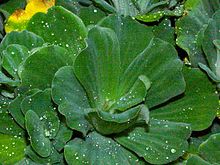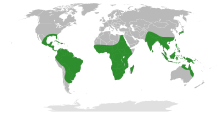Pistia
| Pistia | |
|---|---|
 |
|
| Scientific classification | |
| Kingdom: | Plantae |
| (unranked): | Angiosperms |
| (unranked): | Monocots |
| Order: | Alismatales |
| Family: | Araceae |
| Subfamily: | Aroideae |
| Tribe: | Pistieae |
| Genus: |
Pistia L. |
| Species: | P. stratiotes |
| Binomial name | |
|
Pistia stratiotes L. |
|
 |
|
| Range of the genus Pistia | |
| Synonyms | |
|
|
Pistia is a genus of aquatic plant in the arum family, Araceae. The single species it comprises, Pistia stratiotes, is often called water cabbage, water lettuce, Nile cabbage, or shellflower. Its native distribution is uncertain, but probably pantropical; it was first discovered from the Nile near Lake Victoria in Africa. It is now present, either naturally or through human introduction, in nearly all tropical and subtropical fresh waterways. The genus name is derived from the Greek word πιστός (pistos), meaning "water," and refers to the aquatic nature of the plants.
It is a perennial monocotyledon with thick, soft leaves that form a rosette. It floats on the surface of the water, its roots hanging submersed beneath floating leaves. The leaves can be up to 14 cm long and have no stem. They are light green, with parallel veins, wavy margins and are covered in short hairs which form basket-like structures which trap air bubbles, increasing the plant's buoyancy. The flowers are dioecious, and are hidden in the middle of the plant amongst the leaves. Small green berries form after successful fertilization. The plant can also undergo asexual reproduction. Mother and daughter plants are connected by a short stolon, forming dense mats.
Water lettuce is among the world's most productive freshwater aquatic plants. In waters with high nutrient content, particularly those that have been contaminated with human loading of sewage or fertilizers, water lettuce can often exhibit weedy overgrowth behavior. It may also commonly become weedy in hydrologically altered systems such as canals and reservoirs.
It is a common aquatic plant in the southeast United States, particularly in Florida. It was originally noted in Florida by the explorers John and William Bartram during the period of 1765-1774, and fossil reports in Florida dating to the late-Pleistocene (~12,000 BP) and early Holocene (~3,500 BP) indicate its native presence in southeast North America.
...
Wikipedia
